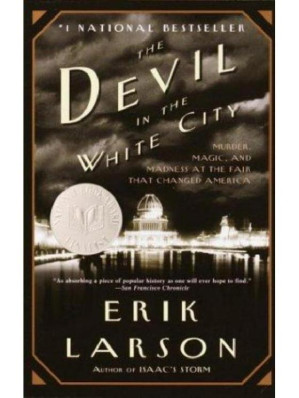Make no little plans; they have no magic to stir men's blood.
Daniel Burnham's grand vision represented American ambition and progress.

Book summary
by Erik Larson
Architecture, ambition, and murder at the 1893 Chicago World's Fair
Murder, magic, and madness at the fair that changed America
Topics
Read this book as a dual narrative, alternating between chapters about architectural achievement and true crime. Use Readever to track the parallel timelines and highlight how Larson builds suspense through historical detail. Pay attention to the contrast between Burnham's public triumphs and Holmes's private horrors, and use the AI to explore deeper historical context about the Gilded Age and early forensic science.
Things to know before reading
Erik Larson's gripping narrative nonfiction weaves together two parallel stories from the 1893 Chicago World's Fair: the brilliant architect Daniel Burnham's heroic effort to build the magnificent "White City" that would showcase American progress and innovation, and the chilling tale of H.H. Holmes, a charismatic doctor who built a "Murder Castle" near the fairgrounds and became one of America's first serial killers.
Larson's narrative explores the dual nature of progress and innovation, showing how ambition and darkness can exist side by side in moments of great societal transformation.
Daniel Burnham's grand vision represented American ambition and progress.
H.H. Holmes exploited the anonymity and excitement of the fair for his crimes.
The juxtaposition of architectural marvel and serial murder reveals societal contradictions.
Ready to continue? Launch the Readever reader and keep turning pages without paying a cent.
This summary reveals Larson's masterful storytelling that juxtaposes the grandeur of American ambition with the darkness lurking in its shadows. You'll discover why this book has captivated readers with its exploration of how progress and horror coexisted during one of America's most transformative moments.
Key idea 1
Daniel Burnham's grand vision represented American ambition and progress.
The construction of the White City embodied the optimistic spirit of the Gilded Age, showcasing American technological innovation, architectural brilliance, and belief in progress. Burnham's ability to overcome immense obstacles—tight deadlines, labor disputes, and engineering challenges—demonstrated the power of vision and determination to transform reality.
Remember
Key idea 2
H.H. Holmes exploited the anonymity and excitement of the fair for his crimes.
While the White City represented American progress and optimism, Holmes's Murder Castle represented the dark underbelly of urban anonymity and the vulnerability created by rapid social change. His ability to operate undetected for years demonstrated how progress could create new opportunities for evil as well as good.
Remember
Key idea 3
The juxtaposition of architectural marvel and serial murder reveals societal contradictions.
The coexistence of Burnham's magnificent achievement and Holmes's horrific crimes during the same event reveals the complex nature of human society. The fair represented both the heights of human creativity and organization and the depths of human depravity, showing how civilization and barbarism can exist simultaneously.
Remember
The Devil in the White City: Murder, Magic, and Madness at the Fair That Changed America tells the parallel stories of the 1893 Chicago World's Fair. The book follows Daniel Burnham, the fair's chief architect, as he overcomes immense challenges to create the magnificent White City that would showcase American innovation and progress.
Simultaneously, the narrative follows H.H. Holmes, a charismatic doctor who built a hotel near the fairgrounds that became known as the "Murder Castle." Holmes used the anonymity and excitement of the fair to lure victims, becoming one of America's first documented serial killers while the nation celebrated its achievements just blocks away.
Open Readever's reader to highlight passages, ask the AI companion questions, and keep exploring without paying a cent.
Larson's masterful storytelling combines meticulous historical research with narrative techniques typically associated with fiction, creating a book that reads like a thriller while remaining faithful to historical facts. His ability to bring historical characters to life and create suspense from known historical events has made this book both a critical and popular success.
Readers who enjoy narrative nonfiction and true crime
Those interested in American history and the Gilded Age
People who appreciate stories about architecture and urban development
Anyone interested in the complex relationship between progress and its unintended consequences
Erik Larson is an American journalist and author known for his narrative nonfiction. Born in 1954, he has written several bestselling books that combine historical research with compelling storytelling. His work is characterized by meticulous attention to historical detail and the ability to create suspense and drama from real historical events.
Build your personalized reading stack
Download full-length ePubs in one click with personal cloud storage.
Blend AI-guided insights with tactile note-taking to accelerate reflection.
Follow curated reading journeys tailored to your goals and time budget.
Sync highlights across devices so lessons stick beyond the page.
Sign in to Readever to keep reading with AI guidance, instant summaries, and synced notes.
The Devil in the White City tells the gripping parallel stories of architectural triumph and serial murder at the 1893 Chicago World's Fair. Larson's masterful narrative explores how ambition, progress, and darkness coexisted during one of America's most transformative moments, revealing the complex nature of human society and the thin line between civilization and savagery.
This extended outline captures Larson's masterful storytelling and exploration of the dual nature of progress and ambition. Use it to experience the parallel stories of architectural triumph and serial murder that unfolded during one of America's most transformative moments.
The book's power lies in its ability to juxtapose the heights of human achievement with the depths of human depravity, revealing how progress and darkness can exist side by side and how moments of great societal transformation contain both light and shadow.
Start reading The Devil in the White City for free and unlock personalized book journeys with Readever.